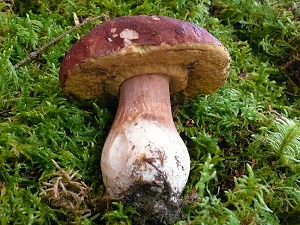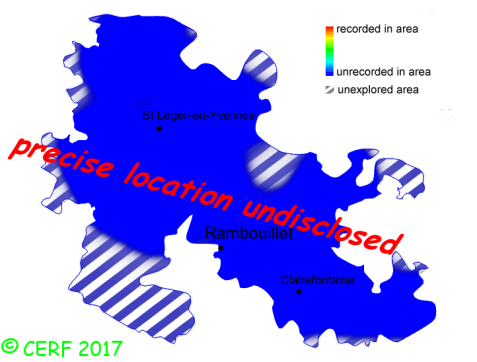| Boletus pinophilus Pilát & Dermek |
|
|
|
|
|
|
The cap is mahogany red, chestnut to dark red-brown, uniform except at the margin which is paler, fleshy, more or less wrinkled, bumpy, thick, hemispherical then convex then more or less flattened. The cap surface is matt, matt to velvety when dry, smooth and greasy or viscous in damp weather, often with a whitish topping on young specimens. The cap margin is often overhanging, with a white or yellow line mostly visible in the youth. The stem is sturdy, thick, full, short, bulbous at its base, pale red-orange to red-brown. A network is present on almost the whole stem, composed of whitish mesh cells, becoming reddish towards the stem base or when touched. The flesh is thick, firm to spongy, white, except under the cap surface, tinted with the cap's colour (reddish), unchanging when exposed to air; its taste is pleasant, mild; the odour is pleasant (of freshly mowed lawn according to some authors) ; The tubes are thin, easily removed from cap, long, pale then yellow-greenish to green-brown, almost free, unchanging when exposed to air. The pores are small, round, regular, white or yellow from the start, then greenish yellow to green brown (concolorous to tubes), not changing colour when pressed. The spore print is olive brown. It grows more often in southern Europe and high altitudes, with conifers, and more rarely with broad-leaved trees, on a rather acid soil, with Scots pine, red fir, spruce, oak, hornbeam, chestnut, beech. The fruiting period takes place from April to December.
Chemical tests : positive reaction to iron sulphate (flesh turns green). Distinctive features : reddish shades: reddish-dark brown cap, cinnamon to reddish network on white to ochre-red stem; greasy looking cap when young; margin with narrow whitish rim, slightly umbonate when young; preferably under conifers Boletus pinophilus is quite rare and localised in the forest of Rambouillet, and is infrequent, more generally speaking . | ||
|
page updated on 14/01/18

